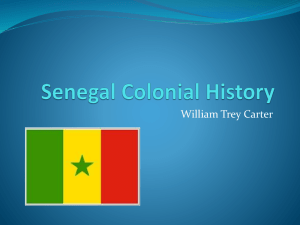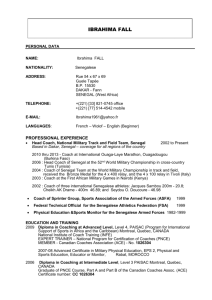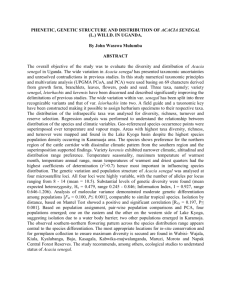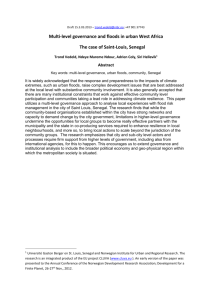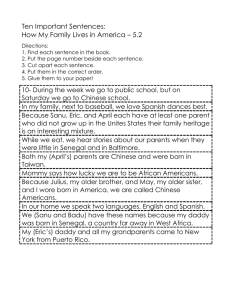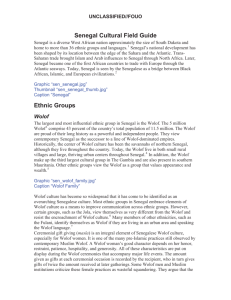MUSIC
advertisement
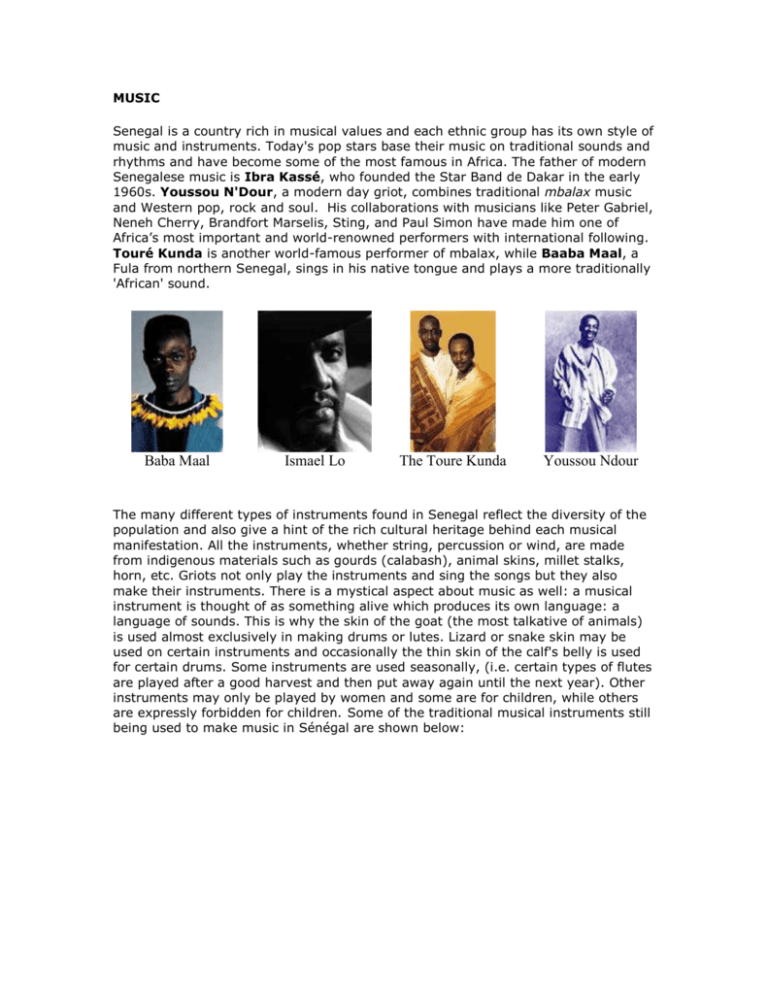
MUSIC Senegal is a country rich in musical values and each ethnic group has its own style of music and instruments. Today's pop stars base their music on traditional sounds and rhythms and have become some of the most famous in Africa. The father of modern Senegalese music is Ibra Kassé, who founded the Star Band de Dakar in the early 1960s. Youssou N'Dour, a modern day griot, combines traditional mbalax music and Western pop, rock and soul. His collaborations with musicians like Peter Gabriel, Neneh Cherry, Brandfort Marselis, Sting, and Paul Simon have made him one of Africa’s most important and world-renowned performers with international following. Touré Kunda is another world-famous performer of mbalax, while Baaba Maal, a Fula from northern Senegal, sings in his native tongue and plays a more traditionally 'African' sound. Baba Maal Ismael Lo The Toure Kunda Youssou Ndour The many different types of instruments found in Senegal reflect the diversity of the population and also give a hint of the rich cultural heritage behind each musical manifestation. All the instruments, whether string, percussion or wind, are made from indigenous materials such as gourds (calabash), animal skins, millet stalks, horn, etc. Griots not only play the instruments and sing the songs but they also make their instruments. There is a mystical aspect about music as well: a musical instrument is thought of as something alive which produces its own language: a language of sounds. This is why the skin of the goat (the most talkative of animals) is used almost exclusively in making drums or lutes. Lizard or snake skin may be used on certain instruments and occasionally the thin skin of the calf's belly is used for certain drums. Some instruments are used seasonally, (i.e. certain types of flutes are played after a good harvest and then put away again until the next year). Other instruments may only be played by women and some are for children, while others are expressly forbidden for children. Some of the traditional musical instruments still being used to make music in Sénégal are shown below: JEMBE The jembe is perhaps the best-known West African instrument. It originated with the Malinke in Mali, Guinea, and eastern Senegal, but has become the drum of choice for many groups throughout West Africa. It is the only instrument to become so popular among all ethnic groups and castes that many do not even recognize is as a "griot" instrument. Despite being primarily a Malinke instrument even Wolof and Sereer griots are learning to play it. Several factors have contributed to the jembe's popularity. It has a much wider dynamic range than any single sabar, meaning that a lone jembe can produce the range of tones that only a full ensemble of sabars can produce. It also has a rich, bright, and resonant tone. One of the most thrilling experiences in Senegal is to watch the jembe players of the Ballet National battling back and forth, working up to an almost deafening and intoxicating climax. The instrument is hollow, made out of a single piece of wood, covered with goatskin and stretched with a braided cord. The drum is played with hands. Each musician personalizes his instrument by adding metal bells (the sese, seseke or ears) to give it a metal tinkling. SABAR By far the most common instrument in Senegal, the sabar can be found at every family gathering, meeting and rally. . Usually played by Wolof and Sereer griots, the sabar has become the backbone of almost every Senegalese music group. Contemporary Senegalese popular and semi-traditional music is generally designated as "mballax," named for a family of traditional sabar dance rhythms ubiquitous in Senegalese music. A group of sabars is an essential ingredient in all such music. The music is played with a neunde, drum cut out of a solid piece of wood, in the shape of a cylinder, and covered with a goatskin. The skin is stretched with the aid of a strap and a wooden stick. The percussion is played with the aid of a stick, which gives a very characteristic sonority. The soloist is often accompanied by a thiol and the bang bang, instruments of the same family. The sabar is today world known thanks to Doudou Ndiaye Rose, who has composed a neunde orchestra. Sabars usually play in groups of at least three and sometimes even dozens. Doudou Ndiaye Rose, sometimes includes over a hundred of his children and grandchildren in his concerts. The sabars repeat complementary and predetermined patterns, each player occasionally breaking from his pattern to improvise. All the players watch the nder player for sometimes abrupt and complicated transitions between rhythms. As with any other instrument in Senegal, sabar players are traditionally only male, although in some rare settings, females also play. TAMA The tama is nearly as common as the sabar and is played by a larger number of ethnic groups than the sabar, including the Wolof, Sereer, Fulbe, Tukuloor, Malinke, and Mandinko. The tama is a "talking drum," or a drum whose pitch can be regulated. The player puts the tama under one shoulder and beats the tama with a curved stick held in the other hand. To regulate the pitch, the player squeezes the strings that surround the tama with his arm, tightening the drum head and thereby raising the pitch. Because it can imitate the inflections of the human voice, certain patterns have literal verbal meanings, although to most Senegalese today, the tama is simply an instrument used to accompany dance and concert music. very small, with a diameter of about 4 to 5 inches, the royal tama, which are extremely rare now, were almost twice as large. Tamas are used primarily to accompany dancing or griots' chants. The Wolof in most areas have little tradition of melodic singing, and griots' "praise singing" is often actually rhythmic chanting to a percussive accompaniment, much like rapping. The tama is an important part of almost all modern mballax groups. Although it is not quite as indispensible as the sabar, it adds a flavor that most groups consider to be an integral part of their music. Assane Thiam, the tama player of Senegal's most famous singer, Youssou Ndour, has made a solo career recording somewhat traditional Wolof rhythmic chants. Thiam's reputation as a virtuoso tama player is similar to the reputation of Western guitarists like Jimmy Hendrix. More rustic than the kora, the bolon is a large harp-lute with three or four strings tied by leather thongs to a curved neck. Its soundbox is made from a large calabash covered by laced goatskin. This instrument belongs to the professional musicians of the Mandinka people, it could be played in instrumental pieces or to accompany singing. Kora A 21-stringed harp lute originating with the Mandinko of the Gambian River Valley, the kora is one of the most popular instruments in Senegal. It is made of a calabash (gourd) with fishing-line strings. Differing slightly from region to region, this harp-lute is one of the most melodic instruments in Africa - a fountain of clear crystal sounds. Traditionally its strings (10-23) were made of leather or gut but have been, step by step, replaced by nylon fishing lines which are both more practical to replace and produce a sharper sound. They are divided into two parallel groups. The reasonator is a large hemispherical gourd (60-70cm) covered by hide that is placed on the ground to amplify the bass of the instrument. Its long neck has leather bands to attach and tune the strings. Used mostly by the griots, jeli, the kora represents a typical sound of West Africa - Manding music. The kora is the national symbol of culture for Gambia. balafon. The Nguel The traditional music of the Sereres is played primarily with a turned over calabash "calebasses", the musician uses his ten fingers. The Gamb is a whole calebasse hollowed out, which you strike with your ring finger. The nguel is often organized during the rainy season when the Sereres return to their villages for their rural activities. The Wango The wango is the traditional dance of the Poular. the music is played with a riti or a lehodou, which is a small calebasse on which a ox skin is stretched over' with four cords. In Casamance, the Diolas, the Mankagnes, Soces, Balantes also have their own music, very rhythmic, played with drums, and balafons (xylophone made of wood, with the sound box made with a calebasse), the kessing-kessing and the dioundioug. Traditionally, the tama was a court instrument, used by kings and chiefs to summon people. Although most tama are XALAM The xalam is the most common stringed instrument in Senegal and is played by Wolof, Sereer, Fulbe, Tukulóor, and Mande griots. It usually has from 4 to 6 strings and uses a variety of tunings. It came to Senegal through the Bamana of Mali. GOGE: The single-string fiddle of the Savannah. Like most fiddles, the string is made from horsehair that passes across a notched bridge and is attached to the neck by a leather strap. The soundbox - a half-calabash, a gourd, wood or even an enamel bowl - is from 20 to 50 cm and covered by hide such as lizardskin or snakeskin, with a circular hole. The Assakhalebo The water-drum is made with large gourds, sometimes even buckets or any type of container. The largest part sits on the ground and is filled with water, a smaller up-turned gourd floats upside down and is beaten by finger-rings, sticks, a spoon or even sandals (flip flops). Largely used by women, these drums are played in a rhythmic ensemble with other percussion instruments. Existing traditional Sénégalese rhythms include the Yela. Yela is the music of women, as it mimics the sound they made when pounding grain. When performing the Yela, some women would hit the stressed third beat on their calabashes, while others carried the weaker first beat by clapping their hands. The music dates back to the old Empire and predates colonialization of Sénégal, Sénégalese kings used Yela to call the people of the Empire together so that they could listen to important events. It is the Yela Jimmy Cliff heard when he visited Dakar; and it is reputed to be the primary influence for the development of reggae in the Caribbean. Today, the Pekan songs of the northern fisherman, the Gumbala chants of ancient warriors, the Dilere ditties of weavers plaiting their threads, and the Yela can still be heard, beautifully integrated with the modern musical rhythms. Dance Many occasions are pretexts for a dance party: after a wrestling victory, after the harvest, at a baptism, etc. Usually, every suburb, village or age group has some kind of organizing committee. The most important things are the date, the band, and the invited patrons. The date, because some days are not allowed, for instance there are no dances during the farming season. The band is a group of at least 3 professional drummers, ordinarily between 5 and 7. Sometimes, another instrument, African or European joins them. The venue is a sandy area in the middle of the village or at some crossroads in the town. The youngest sit on the sand in the inner circle. Behind them, the women sit on chairs and benches, or stand up. Finally, on the outer circle, men stand up. Boys and females do the clapping, sometimes using wood or metal clappers. The band plays at a corner of the inner circle, facing the most distinguished patrons dressed in their best clothes, and who will give money to them and to the best dancers. The dancers relay each other almost continuously, in a jubilant disorder. Normally, only women, girls and young boys dance, but men usually dance in the Wolof country. Elsewhere, in the South and the East, religious and age related ceremonies, such as initiations, will offer the opportunity for men and boys in their teens. ART Negritude, originally a literary and ideological movement of French-speaking black intellectuals, reflects an important and comprehensive reaction to the colonial situation. This movement, which influenced Africans as well as Blacks around the world, specifically rejects the political, social and moral domination of the West. The term, which has been used in a general sense to describe the black world in opposition to the West, assumes the total consciousness of belonging to the black race. In contrast to this broad definition, a narrower one pertains to artistic expression. The literature of Negritude includes the writings of black intellectuals who affirm black personality and redefine the collective experience of blacks. A preoccupation with the black experience and a passionate praise of the black race, provides a common base for the imaginative expression in association with romantic myth of Africa. The external factor defining the black man in modern society is colonialism and the domination by the white man, with all the moral and psychological implications. Negritude rehabilites Africa and all blacks from European ideology that holds the black inherently inferior to the white -- the rationale for Western imperialism. Leopold Sedar Senghor, president of Senegal, who further defines Negritude in his poems and writings, rejects the classical white/black view that races can be mutually exclusive saying, "Race is a reality--I do not mean racial purity. There is difference, but not inferiority or antagonism." Senghor believes in the expression of values of traditional Africa as they are embodied in the thinking and institutions of African society, but he does not desire a return to outmoded customs, only to their original spirit. His interpretation of Negritude has become the most clear definition and a model for other writers. Senegal’s art, modern and cerebral, was born and bred under the tutelage of Leopold Sedar Senghor the Poet President who formulated a revalorisation and a recognition of the black race and the "African soul", radically opposed to Western rationalism, individualism and materialism, which he called Negritude. This ideology put to practice was meant to bring about a Renaissance to Black African culture in the heart of Senegalese society Many criticized Senghor for this cultural penchant. These sceptics saw Negritude as an ideology that made for great poetry but certainly a bad economy and even, at times, an artistic dictatorship. This political agenda, based on the idea that culture is the beginning and end to all, belongs now to Senegal's history; and history will judge. At the end of the Senghor era (1980), Senegal's artists were less subsidized but much less under surveillance. A new generation was able to emerge for whom Negritude seemed a thing of the past.. Cultural politics today have changed with the events and economic constraints of a nation in recession. But, as in Senghor's day, the State has recently shown a certain desire to regain its former status as patron and defender of the arts Dakar - which since the First World Festival of Negro Arts in 1966 is considered to be the Metropolis of Fine arts in West Africa - counts over 10 galleries (two state- subsidized), holds seven cultural centres (two state-subsidized), organizes a Biennial of Contemporary African Art and attributes a Grand Prix for the Arts every two years. Underglass painting is one of the oldest Senegalese arts. It is very popular in the towns and even in rural areas. The painting reproduces daily scenes of life. In Senegal they call it "fixé” painting, fixed to the crystal, or by “suwer" from the French expression "sous-verre" (under the glass), The glass painters (that are called "suwer" in wolof) – also called "fixés" in French – is an art specific to the Senegal. Their origin is very old and their theme has developed little by little. The painting often very naive, at the same time tell a story, of everyday life. They can be found hinging on the walls in the city, laying on the sidewalks, and in the shops… The technique is very simple, but requires a high level of skill; starting with an outline first traced in ink, successive layers of paint is applied to the glass. The side not painted lets the picture appear under the thickness of the glass; the painted side is protected with a carton that also services as a support. It is believed that the first glass painting come from the he first glass painting are believed to have come from the mediterranean. It tells the story of the Islam period the battles, the disciples, the prophets and the holy men. In Senegal the great figures of the religious confraternity the resistance against the colonization (Cheikh Amadou Bamba, El Hadj Malick Sy, Limamou Laye, Lat Dior...) have inspired many paintings. Afterwards the art expanded towards family are neighboring scenes, presenting portraits of men and women, the bestiary. The inspiration changed due to current events and tourist demands: you can now find reproductions of book covers from the Tintin albums! Method of producing pictures and ornamental designs on the back of a clear glass panel to be viewed from the opposite side in reflected light. Unlike translucent stained glass, the reverse painted decoration is not fused to the support by firing. The powdered colours are mixed with a binding substance and applied directly to the glass, which becomes an integral part of the picture by providing both the base and the transparent cover for the artwork when the panel is turned. The layer of pigment adheres firmly to the smooth surface, and the colour retains the freshness reminiscent of enamels. Sand painting is one of the most popular Senegalese arts. The technique is strictly limited to the use of local raw material (desert, beach, or volcanic sands for example) and the designs are typically African.

